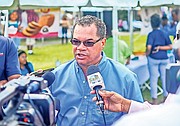Wednesday, December 12, 2018
By AVA TURNQUEST
Tribune Chief Reporter
aturnquest@tribunemedia.net
MOST shanty town dwellers in unregulated communities across Abaco have legal status permitting them to reside in the country, according to Labour Minister Dion Foulkes, who yesterday revealed an estimated population size of around 3,500 residents.
Mr Foulkes said around 20 percent of those surveyed during the summer census exercise were undocumented, adding the six shanty towns were home to at least 332 children.
He remained tightlipped on how many shanty town residents were Bahamian, telling reporters outside the Churchill Building the full report was still before Cabinet.
“The report has a breakdown of those residents who are on spousal permit, work permit and citizenship,” Mr Foulkes said.
“Information on utilities, those employed and unemployed, but that information would be made available to the press. It is before colleagues now.
He added: “One of the figures that I can release this morning is out of all of the residents, 80 percent of them have some type of legal status to be in the Bahamas, 20 percent of them are undocumented.”
The preliminary results appear to follow population trends observed in New Providence shanty towns, where an “overwhelming” 70 percent reportedly have a legal right to reside in the country. In the capital, Bahamian residents stood at 15 percent, and three percent of interviewees had a spousal permit.
Yesterday, Mr Foulkes acknowledged the Abaco census figures were significantly lower than speculative estimates given by both local residents and pundits over the years, and insisted the survey was accurate.
“This is the first time that we have actually done a report since the fires,” Mr Foulkes said. “The Ministry of Health did a report in 2013 and at that time there were 1,024 households, so as you can see there is a decrease of about 100 structures, and we think that is due to the two fires that occurred since 2013.
“We think this survey is accurate. We heard many reports from persons who live in Abaco and persons who have visited that the figures could be anywhere from 2,000 to 7,000 (residents) but what I’ve given to you are the facts. We believe that they are the facts.”
The SATF’s Abaco census started on June 13, and its report was compiled by Dr Cherita Moxey, of the Ministry of Health.
Of the 915 structures recorded, 138 households did not participate, and Mr Foulkes said officials estimate those homes account for about 500 residents.
In the remaining 777 households surveyed in the communities of the Mud; Pigeon Peas; Farm Road; Sandbanks; L & H; and Elbow Cay, there were 3,039 residents.
The South Abaco shantytowns of the Mud and Peas represented the largest population, accounting for 70 percent of the total households interviewed by the task force or around 2,600 residents, according to Mr Foulkes.
Meanwhile, the government’s action plan for the eradication of Family Island shanty towns is still hampered by looming court action from 177 shanty town residents from both New Providence and Abaco.
The Supreme Court previously ordered the government and utility providers to halt any planned evictions, service disconnections or demolitions until the court hearing for a judicial review of the government’s decision.
Yesterday, Mr Foulkes said: “There is a court injunction that has prohibited us from following our action plan but all of the things that we can do, that do not relate directly to the shanty towns, we are doing. One of them is a subcommittee that is considering alternative housing for the residents of the shanty towns on Abaco, but I do not want to get into any detail on that.”
